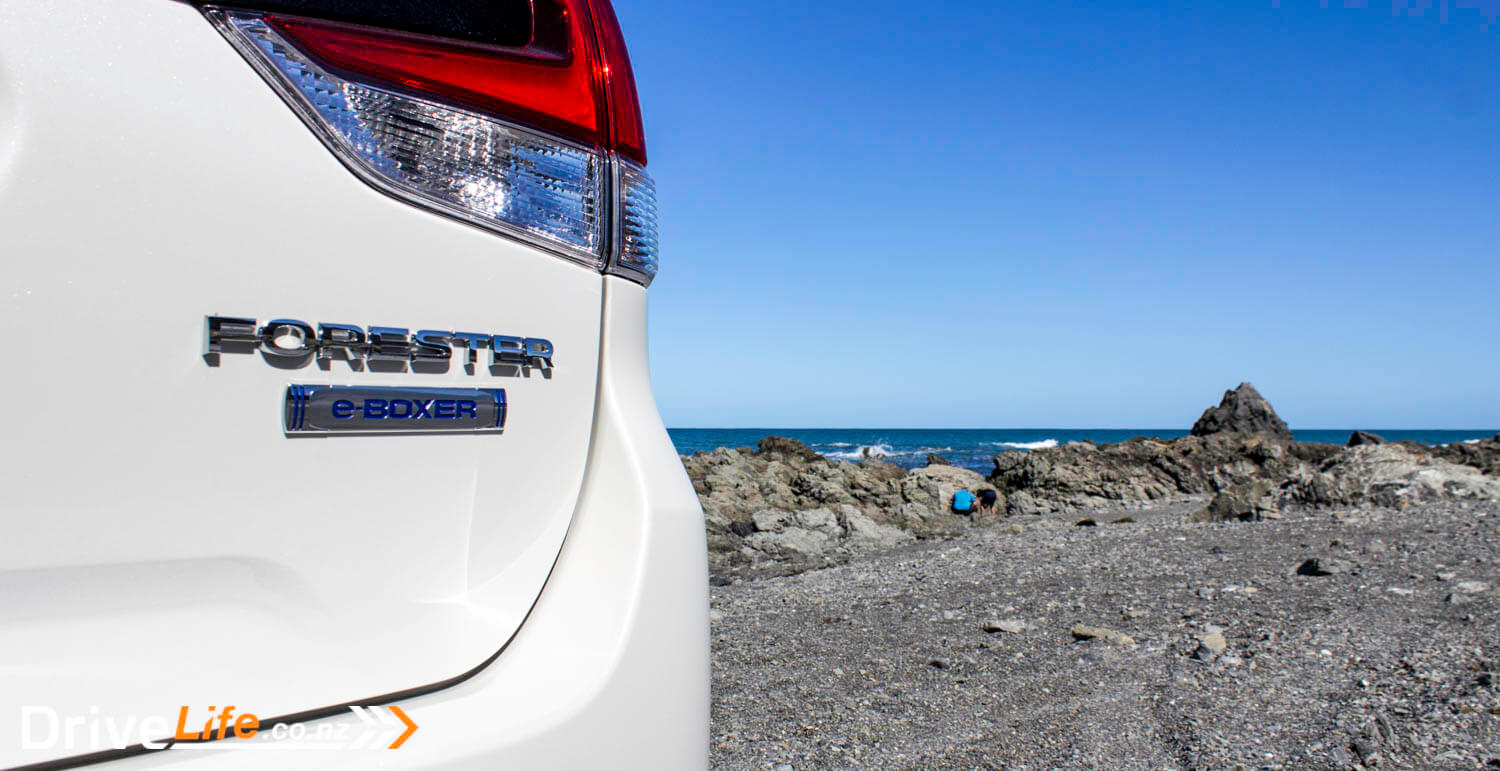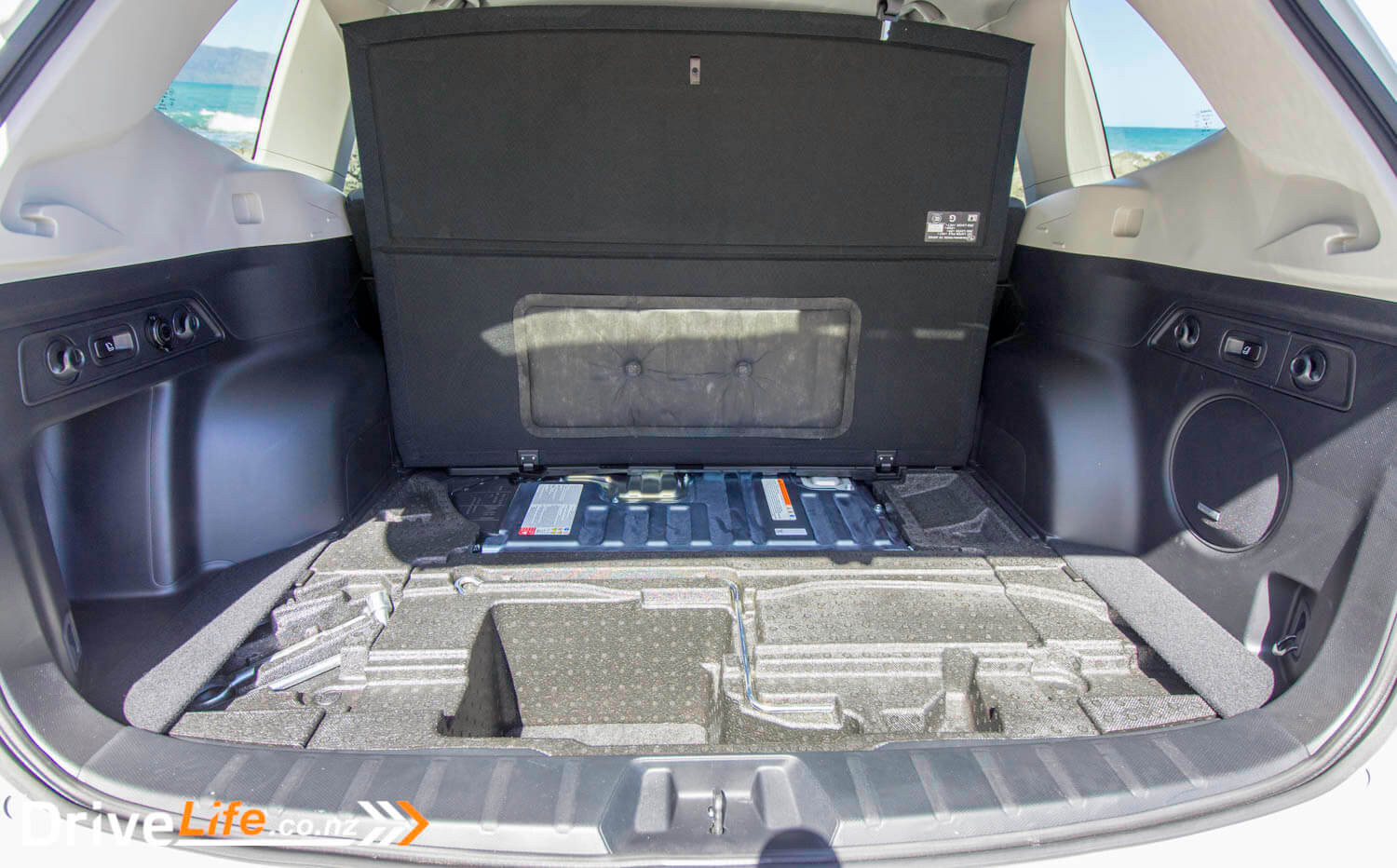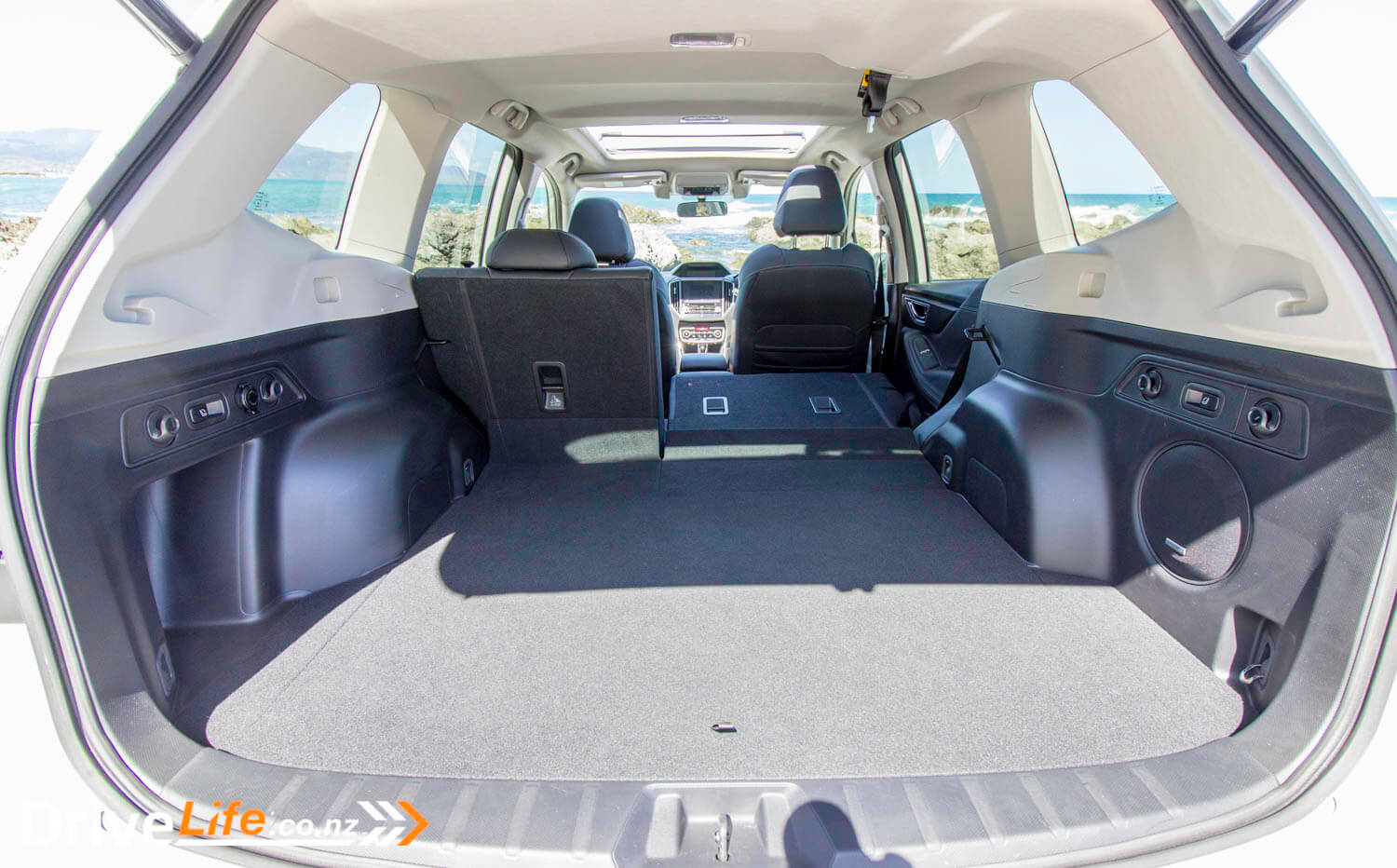Hot on the tail of the Subaru XV Hybrid that Alistair recently reviewed, Subaru sent us the top-spec Forester e-Boxer Premium hybrid for a week’s drive.
A popular adventurer’s SUV, the Forester is a main-stay in many ski field car parks, remote fishing spots, or pretty much anywhere where a ‘normal’ SUV might not want to go. It’s no hard-core off-roader, but it does at least have better off-roading capability than some.
For their 2020 hybrid models, Subaru has decided to drop the engine size down to 2.0-litres, to make it an even better all-rounder. But does it? We put the top-spec Forester Premium e-Boxer to the test for a week to see if it’s a capable hybrid.

What’s In The 2020 Subaru Forester Range?
In the non-hybrid Forester range there are three models, but you only get two options if you want the hybrid model; these are the Forester e-Boxer Sport, and the top-spec Forester e-Boxer Premium (tested).
Both run a 2-litre, 4-cylinder boxer petrol engine, down in size from the 2.5-litre that the non-hybrids are fitted with. Power output for the petrol engine is 110kW, and torque is 196Nm. The electric motor provides an additional 12.3kW of power and 66Nm of torque.

Even the cheaper $47,490 Sport is pretty well equipped, with 17” alloy wheels, heated door mirrors, privacy glass, a rear roof spoiler, shark fin antenna, steering responsive headlights, dual zone aircon, paddle shifters, an electric park brake, hill start assist, X Mode with hill descent, Rear Autonomous Braking, blind spot monitoring, all-wheel drive, Eyesight safety technology (with autonomous braking, adaptive cruise control, lane keep assist, tyre pressure monitoring, LED tail lights, rear cross traffic alert, high beam assist, and lane change assist), 7 airbags, automatic lights and wipers, reversing camera, front LED fog lights, keyless entry and start, 6.5” centre touchscreen display, Apple CarPlay and Android Auto capability, six-speaker audio, and heated front seats.

The $54,990 Premium model then adds SatNav with traffic updates, an electric tailgate, 18” alloy wheels, an 8.0” centre touch screen display, 8-way electric front seats with memory, automatic folding mirrors, auto dipping rearview mirror, leather upholstery, SI Drive with steering wheel controls, X-Mode Dual Function (deep snow/mud), Harman Kardon audio with subwoofer and amp, extra front USB ports, alloy pedals, one-touch electric folding rear seats, and a Driver Monitoring System (with auto driver’s seat adjustment and auto door mirror adjustment).

Both hybrid models cost $5,000 extra over the equivalent non-hybrid Forester.
You can read more about the Forester on Subaru New Zealand’s website.

First Impressions Of The 2020 Subaru Forester e-Boxer Premium Hybrid
It seems that the Forester grows exponentially every new generation, and now feels like a full-size SUV. It’s not full-size but walking around it, it seems to loom over you. It’s boxy, big and a little imposing. Still, it’s distinctively a Forester, and there’s no mistaking that look. 2020 brings a fresh look, and of course two hybrid models.

Our test car, finished in white, didn’t really stand out that much aside from its size, but it’s certainly not a bad looking car, and carries that utilitarian look about it that Forester buyers seem to love.

What’s The Interior Like On A 2020 Subaru Forester e-Boxer Premium Hybrid?
It’s Subaru all over in the interior, the Forester feels like an XV, or even the Outback. There’s the traditional three-screen setup, which makes the car feel a lot more expensive than it is. It’s not cheap but there’s not many cars out there with three separate screens.

Thankfully, being the top-spec model, there wasn’t a single switch blank. We still get this sometimes (like the Yaris ZR Hybrid we tested against the Suzuki Swift Hybrid), however the whole interior feels classy and more expensive than it is. There’s a huge range of textures used – bordering on busy – but the Forester manages to pull it off. There’s alloy pedals too, not sure why, but they’re there. The dash and doors have nice contrasting stitching, and there’s almost no hard plastics in the places where your hands fall to.

The front of the car can feel a little snug, the dashboard seems to curve around the driver and passenger, almost encompassing them. There is plenty of headroom up front though, and the electric sunroof (with a manual blind) lets in a load of natural light. The car comes with beige headlining too, and with the huge rear-door windows, visibility isn’t an issue, except for the kick up at the base of the C pillar. This kick-up in the body does intrude a bit on your visibility though, but there is blind spot monitoring to help keep you safe.
There’s a massive rear window too, and what is possibly the world’s biggest rear window wiper taking care of things. It’s a superb drive on the motorway due to the ability to see all around the car.

Headroom in the rear is a little more restricted, with the electric sunroof to blame. It’s not bad, but the headlining does dip down quite a bit at the rear of the sunroof. Legroom is generous in the rear, probably a bit above average for this size of SUV. Rear seat passengers get two 2.1-amp USB ports back there, grunty enough to charge iPads on those long drives to the mountain in ski season.
You can release the rear seats from the boot, something I always appreciate and not something every car maker does, but this feature is only on the Premium model. There’s also 2 hooks on each side of the boot for plastic bags, not that any Forester buyer would own any plastic bags. As far as convenience items go, you get one 12-volt socket in the cargo area.
Cargo room is very good at 345 litres, but there’s no spare under the floor – only a pump and can of sealant. There is a usable storage area under the floor though, but the biggest thing to catch your eye there is the battery pack, sitting proud.

What Does The 2020 Subaru Forester e-Boxer Premium Hybrid Drive Like?
After a few day’s drive in the XV Hybrid that Alistair recently reviewed, I didn’t want to get my hopes up that the Forester would be better. The XV Hybrid was disappointing in that it barely operated in EV mode, and didn’t seem to save much fuel.

So what of the Forester Hybrid? Like the XV, there’s no EV control; no button to force the car into EV mode – you just get in and drive. If you let the car move forward in traffic without touching the accelerator, it will stay in EV mode, and if you are extremely gentle with that gas pedal, you can almost make it stay in EV mode – but not very often. Any sort of useful amount of prodding of the accelerator will see the engine starting up.

Even going down a hill with a full battery is a struggle for the car, it will initially go into EV mode when you take your foot off the gas, but a slight touch of it will see the engine start. Sometimes without me touching the accelerator and going down a hill, the engine would start at random times. It’s all a bit frustrating, as you feel you have the capability there (with a full or near-full battery) but the car simply doesn’t want to oblige.

Some days as I’d drive down my driveway, the engine would stop and go into EV mode – great! – but then when I put the transmission into Park, the engine would start again? Huh? There’s more bad news on the hybrid front. When the car transitions from EV mode to engine-on mode, there’s an unpleasant jerk while driving. After a week, I managed to drive my way around this so it wasn’t so obvious, but still, the problem is there.

As far as battery capacity goes, the one in this car is 4.8 amp-hours (Ah). As a comparison, the hybrid battery in the Suzuki Swift is small at 10Ah, so you can see that the Forester Hybrid is definitely on the mild hybrid side of things.
It feels more like an assist system than anything else; since the 2.5-litre engine has been replaced by a smaller 2.0-litre motor, the car needs the electric assist to give it the same performance, and yet still save fuel. So – does it work? In the real world, no. Performance is bordering on okay, but load the car up with 4 people, and it can feel lethargic. I’d not like to see it going away for a long weekend with 4 or 5 passengers and a load of luggage. I suspect it’d use more fuel than the 2.5-litre car.

One of the dashboard screens actually tells you how much gas you are saving as you drive. After a 2.5-hour stint behind the wheel, I managed to save 1.5 litres, but I’ve got to say I was trying really hard to save as much as I possibly could, feathering the throttle everywhere to try and keep the car in EV mode.
But it does save fuel, right? I drove the Forester Hybrid for 500Km, and it gave me 7.8L/100km. Subaru suggests it should give a combined rating of 6.7, and in the scheme of things, I wasn’t too far off. When Rob Clubley tested the 2.5-litre Forester, he got 8.6L/100Km, so I was definitely better than that, saving nearly a litre per 100Km. But was it worth it? You pay a $5,000 premium for the Forester Hybrid, and saving say $1 per 100Km means it would take 500,000Km of driving to break even on that money spent.

Enough of hybrid stuff, what about the rest of the Forester? I haven’t driven one since the last generation, and other than the size difference, it felt pretty similar overall. Both front windows are auto up/down, which is a nice touch. There’s an electric sunroof with a manual blind, and it was nice to have this open when I took the car for some light off-roading for photos.
And this is where the Forester, hybrid or not, excels. Driving through deep sand on the way to take photos simply wasn’t an issue. There were no ground clearance issues either, and I put the X-Drive mode into Snow/Dirt, but I didn’t need to; the Forester just went where I pointed it. You can also select Deep Snow/Mud on the X-Drive dial, and electronics will assist you in getting through it. It was nice when I had the X-Drive in Snow/Dirt mode and then went to go down a hill; lift your foot off the gas pedal, the car automatically uses hill descent control to take you down. Brilliant. Another thing that happens when you use X-Drive, is that the top-centre display automatically changes to show you your rollover angles, and approach and departure angles.

All Foresters have Subaru’s Eyesight system, which gives you a huge list of safety features, like adaptive cruise control. It also has a Driver Monitoring System, which watches the driver’s eyes to see what they are doing. If you look to the car alongside you for too long, you’ll get a beep and a warning on the dash to keep your eyes on the road. Look down for too long – perhaps nodding off – and another and a warning to stay alert. It’s a little spooky, but a nice safety feature.

The lower-centre screen is nicely high resolution, with SatNav built-in. It’s well integrated too, and could be a lesson to some other brands that insist on tacking their display on top of the dash (cough-Mazda-cough!). The screen can lag a bit if you swipe left or right to see the other options, but actual usage is not too bad. There’s not a 360-degree camera system in the Forester Premium, but you do get a Front View and Rear View buttons on the centre console to flick between these cameras. The Front View button also pulls up a kerbside camera, great for parking.

All Subarus are well known for lots of beeping, and the new Forester is no different. It’s the adaptive cruise beeping that really drives you crazy, and for this year, Subaru have gone a step further, adding a green light to the top of the dash, to tell you when adaptive cruise is on, and then flashing if a car pulls into your lane, or out of your lane. This is of course as well as the beeping. At night, the green light reflects on the windscreen, distracting you as well. Does it drive you crazy? Yes, it does.
There is still the very handy vehicle alert that a car has moved off in front of you. Handy in traffic jams when you are writing notes, and the car has moved away. Saves tooting from behind.
The seats are comfy, but there’s not enough side support, as any sort of corner will see you and your passengers rolling about a bit. I’m not going to start preaching that the Forester Hybrid is some sort of handling beast; it isn’t, and isn’t supposed to be. Any sort of vigorous driving will see the car understeer, as is to be expected. The grip is still there with the all-wheel-drive system, and the car does feel safer to drive knowing you have that in your back pocket.

If you do decide you want to punch it around some corners, you might want to change the drive mode from I to SI. This alters transmission change points and holds the gears longer, making the car feel gutsier off the line. But other than acceleration from a standstill, the engine just revs out and really, you are better off using any torque for maximum forward momentum. When tootling around town or on the motorway, the CVT transmission behaves nicely, and will do little ‘gear changes’ to give you a feeling of a real automatic, and it feels better to drive. Weirdly, if you floor the car, you don’t get any stepped mode at all, just lots of revving; the car will sit at 6,000rpm, and CVT flaring is evident. For me, this feels the opposite to what it should be; when I floor it, that’s when I want the stepped mode to kick in.

The ride on this car is excellent – it’s one of the highlights. The Forest Hybrid soaks up any and all bumps, riding like a limo. On the motorway, there’s some wind noise from the top of the A pillar, but it’s not too bad. There is some tyre and road noise too, but at a steady throttle, the whole car is on the quieter side of things.
On the daily drive then, things are good – hybrid frustrations aside. The sun visors have extensions, something we don’t see enough of, so thank you Subaru. There’s brake auto-hold, and I always use this, but it’s a shame it doesn’t come back on with the car. The heated seats do though, so that’s a bonus.

What’s The Competition For The 2020 Subaru Forester e-Boxer Premium Hybrid?
| Brand/Model | Engine | Power/ Torque kW/Nm | Cargo capacity, litres | Fuel consumption, L/100km | Price |
| Subaru Forester e-Boxer Premium Hybrid AWD | 2.0-litre, 4-cylinder petrol/hybrid | 110/262 | 345 | 6.7 | $54,990 |
| Kia Niro Hybrid SX FWD | 1.6-litre, 4-cylinder petrol/hybrid | 77/147 | 401 | 3.8 | $44,990 |
| Subaru XV e-Boxer Sport Hybrid AWD | 2.0-litre, 4-cylinder petrol/hybrid | 110/262 | 310 | 6.5 | $42,490 |
| Toyota C-HR Limited Hybrid FWD | 1.8-litre, 4-cylinder petrol/hybrid | 72/142 | 318 | 4.3 | $40,490 |
What’s The Pros and Cons For The 2020 Subaru Forester e-Boxer Premium Hybrid?
| Pros | Cons |
| Spacious Visibility Well equipped Safety features Off-road ability All-wheel drive safety in your pocket Ride quality | $5K premium for little gain Can be noisy Lethargic at times Doesn’t save much fuel Beeping and lights |
2020 Subaru Forester e-Boxer Premium Hybrid – Specifications
| Vehicle Type | 5-door medium AWD hybrid SUV |
| Starting Price | $54,990 |
| Price as Tested | $54,990 |
| Engine | 2.0-litre, four-cylinder boxer engine with e-Boxer hybrid system |
| Power, TorquekW/Nm | 110kW@6,000rpm 262Nm@4,000rpm (combined) |
| Transmission | CVT with 7-speed stepped mode |
| 0-100km/h, seconds | n/a |
| Spare Wheel | Full-size spare |
| Kerb Weight, Kg | 1,576 |
| Length x Width x Height, mm | 4465x1800x1595 |
| Cargo Capacity, litres | 345/919 |
| Fuel capacity, litres | 48 |
| Fuel Efficiency | Advertised Spec – combined – 6.7L/100km Real World Test – combined – 7.8L/100km Low Usage: 0-6 / Medium Usage 6-12 / High Usage 12+ |
| Towing Capacity Kg, unbraked/braked | 650/1,270 |
| Turning circle, metres | 10.8 Small: 6-10m / Medium 10-12m / Large 12m+ |
| Warranty | 3 years, unlimited kilometres |
| ANCAP Safety Ratings | 5 Star |



















































